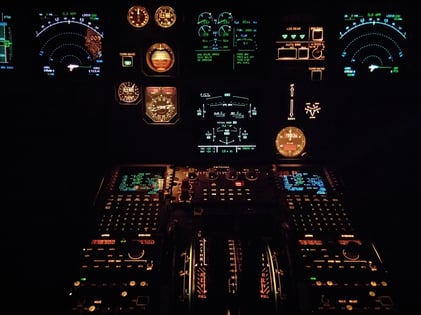Air Travel and SWIR Vision
Among the multitude of applications for SWIR sensors, one that often goes unnoticed but holds immense importance is aircraft safety and landing equipment. Every day, over 6 million people rely on advanced aviation technology to ensure their safe arrival at their destinations. With a staggering estimate of 100,000 flights taking place daily and a soaring demand, global commerce and travel cannot be hindered by unfavorable weather conditions or the time of day. Pilots frequently encounter heavy fog, clouds, and rain, making it essential for them to rely on sensor systems capable of seeing beyond obstructions that are otherwise impossible to navigate with the naked eye. Enter SWIR (Short-Wave Infrared) imaging modules, one of the instrumental tools used for sensing beyond what is visible. These modules are powered by a SWIR image sensor, an ultra-sensitive chip that surpasses human vision and seamlessly communicates critical information to the aircraft's computer system. So, how exactly do these sensors work, and why is short-wave infrared light employed in this technology?
 The light spectrum, more appropriately referred to as the electromagnetic spectrum, encompasses gamma rays (high energy, short wavelength) to Radio waves (low energy, long wavelength). Within this mix lies the miniscule visible light spectrum, ranging from about 400nm to 700nm. Just beyond visible light lies the Near Infrared and Short-Wave Infrared spectrum. These wavelengths are commonly defined from 750nm-3000nm and used in several industrial applications. Wavelengths within this range tend to scatter less when interacting with water vapor, allowing the light to pass directly through, in comparison to visible light which scatters and absorbs into water, leading to worst visibility. The sensor technology typically involves materials such as Indium Gallium Arsenide that can easily absorb SWIR wavelengths. One downside of this is the addition of rare materials adds to the cost of the sensors, making them difficult to adapt to large scale projects without a significant budget.
The light spectrum, more appropriately referred to as the electromagnetic spectrum, encompasses gamma rays (high energy, short wavelength) to Radio waves (low energy, long wavelength). Within this mix lies the miniscule visible light spectrum, ranging from about 400nm to 700nm. Just beyond visible light lies the Near Infrared and Short-Wave Infrared spectrum. These wavelengths are commonly defined from 750nm-3000nm and used in several industrial applications. Wavelengths within this range tend to scatter less when interacting with water vapor, allowing the light to pass directly through, in comparison to visible light which scatters and absorbs into water, leading to worst visibility. The sensor technology typically involves materials such as Indium Gallium Arsenide that can easily absorb SWIR wavelengths. One downside of this is the addition of rare materials adds to the cost of the sensors, making them difficult to adapt to large scale projects without a significant budget.
SeeDevice sets itself apart through its innovative use of a purely CMOS-based construction. Unlike traditional CMOS image sensors that are made of silicon and have limitations in capturing wavelengths beyond visible light, SeeDevice introduces its groundbreaking QMOS - Quantum-based CMOS-SWIR sensor. This sensor incorporates a unique structure that extends the usable wavelength of the CMOS sensor beyond the visible spectrum, paving the way for unprecedented capabilities in aircraft safety and landing equipment.



